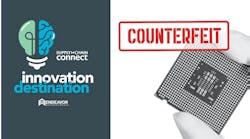In the first episode of Innovation Destination’s latest podcast series—Counterfeit Chronicles—guest Richard Smith, VP of Business Development at ERAI, explains how e-waste contributes to the counterfeit electronic component problem and what it means for industry stakeholders.
This interview was edited and formatted for clarity.
Tyler Fussner, Managing Editor, Supply Chain Connect
Hello, and welcome to Counterfeit Chronicles—the newest series at Innovation Destination. As always, I’m your host, Tyler Fussner, the managing editor at Supply Chain Connect. Joining me today is Richard Smith, Vice President of Business Development at ERAI. Hi, Richard.
Richard Smith, VP Business Development, ERAI
Tyler, how are you doing? Thanks for having me today.
Fussner
Thank you for joining us. For our audience members that are unfamiliar with ERAI, can you tell us a little bit about the association?
Smith 0:39
ERAI was formed in 1995 as an industry association to clean up, police and promote the electronic component distribution world to the manufacturing community. Back in ’95, most of the incidents that we tracked and reported were just bad business practices. And then, around the time China joined the World Trade Organization, in the year 2000, we received our first report of a counterfeited integrated circuit. And since that time, we have put together the largest known database—bar none—of counterfeit and non-conforming electronic components. Companies reported having shipped those components.
And those two items with all the other supply chain issues that we track and report, for instance, wire fraud, that has just exploded over the last couple of years, we provide business, industry and government intelligence to navigate the supply chain to avoid bad product and bad companies.
Fussner 1:49
Richard, I’m really excited to dive into the large-scale problem that is counterfeit. With this first episode of our series, I would like to deliver the historical overview of counterfeit activity. Being that ERAI has had their hands in the trenches working on this issue for decades now, you’re the perfect guy to speak to. My first question for you is—let’s start with the basics—can you give us the simple definition of counterfeit products / counterfeit parts?
Smith 2:17
A counterfeit is anything that’s presented as something that it’s really not. Counterfeiting is such a big broad field. The FBI and the International Property Rights Center come up with huge numbers in the billions and billions of dollars that counterfeit materials effect. But they cover every imaginable product: counterfeit golf balls, counterfeit golf tees, counterfeit Louis Vuitton bags… At ERAI, we look at counterfeit electronic components and the damage that they can cause. I have close to 16,000 unique line items in my database that have been reported as counterfeit over the years.
Counterfeiting is a criminal activity. Let’s start with that. And it can be a criminal enterprise representing something that is of higher quality than what they are shipping, and they’re trying to make up for that difference in pricing. A lot of times they’ll ship used product that has been cleaned up to look new, charge you the new price for it, and then you get it, and it doesn’t work because it has so much use on it.
When counterfeiting gets into the electronic supply chain, we’re talking critical applications like defense and aerospace, health care, medical equipment, automotive… There was a case years ago where counterfeit electronics were found in the electronic brake system of a train. There have been many cases of military equipment failing in the field because of counterfeit material. And then going back to the early 2000s, counterfeiting became such a big deal that it got the attention of the U.S. government, specifically the Department of Defense, and standards were developed and put into place, which industry has really done a good job adhering to over the years. And that’s helping a great deal.
The problem is that counterfeiting is a moving target. An example that I give: From the year 2000 to the end of 2018, every single year the number one most counterfeited device was some integrated circuit or another. Then in 2019 for the very first time, the number one most counterfeited device was a very inexpensive, cheap and dirty, multi-layer ceramic chip capacitor. The point is that business and industry could have tightened down their supply chain, done a good job and made sure they weren’t going to get any bad counterfeit integrated circuits that year—and then out of nowhere come counterfeit capacitors. And the part numbers change from year to year. And we’ve been tracking that information.
As good a job as industry does, you just never know—and you can’t predict—what the next type of counterfeit devices are going to be.
Fussner 5:13
It’s certainly an extensive issue, and it seems to stretch and reach its fingers into every nook and cranny of any industry imaginable.
Richard, what would you attribute as to the most predominant sources of counterfeit parts? Where’s this problem really stemming from?
Smith 5:31
The most common counterfeit electronic component is re-worked or re-marked e-waste. North America and Europe ship 1,000s of tons of electronic waste to China every year on barges. China is pretty much ground-zero for that type of counterfeit activity. They take these scrap boards that have come from our scrap desktops, laptops, cell phones, industrial equipment, telephone key switches, mainframe computers—any old electronic scrap that North America and Europe does not want to see in a landfill ends up on a barge to China.
The Chinese have set up—and I’ve been there, I’ve seen them—entire communities where they take this e-waste, this scrap. They take these circuit boards one at a time, put them over a Bunsen burner, heat it up and shake all the parts off of it. They sort these parts by size and shape, typically with no regard for the device-type or what the chip is inside the part. They take a lot of parts that look the same, process them, resurface them and then mark them with whatever part number and logo that they’re trying to sell you.
So, you get these parts and they’re—for the most part—junk. They may or may not work at all. And if they do work, they won’t work for long because they’ve been so mishandled. That is still—re-worked e-waste—the most common form of counterfeiting that we see.
There are others, much more sophisticated. Some counterfeiters substitute an inferior brand. It might be a brand-new, unused device, but it’s an inferior, less-expensive brand. They will re-mark that with the part number and logo of a higher-quality, more expensive, more desirable brand. That’s another form of counterfeiting.
You get up to the really high-end (which is mostly defense and aerospace), they’re looking for counterfeiting that is not just a criminal enterprise, but state actors are involved. Its malicious code being built into telecom devices and electronics that can be used, say in defense or navigation equipment. I typically use extremes to make a point. The sort of insidious code, counterfeit-type devices that are concerned now are where you would build a missile, and (unknown and unseen) in the device is code that causes the missile to make a U-turn after it’s five miles out. Now, it’s still a little bit farfetched, but it’s theoretical and people seeing indications of counterfeit components heading that direction.
Fussner 8:23
Like you opened up with, something that you said is that the goalpost is always moving with counterfeit.
Smith 8:30
A moving target, indeed.
Fussner 8:32
It’s hard to get a grasp on it and understand where it’s going. What would you say is the true extent of counterfeiting? Is it really everywhere you look? What are the impacts and implications to how you operate your business?
Smith 8:45
There are certainly known best practices. The most common are to only purchase electronic components directly from the manufacturer or their franchise distribution supply chain. It’ll greatly reduce your chance of getting counterfeit, but it doesn’t make it zero, necessarily. You’ll get it into 99.999% just by following that best practice.
Unfortunately, and having been in this industry for 40 years, I know that on any given day, the franchise supply chain simply cannot fill all the requirements there are around the world. That’s why there’s a very robust secondary market: the independent distributors, the brokers, the resellers. Some of these guys have been around for 60, 70, 80 years. And that secondary market has always existed because of the shortcomings of the mainstream franchise marketplace or distribution channel.
Manufacturers are often faced with the need to go out into the secondary market and procure product. There is a separate set of standards that if you adhere to, you can greatly reduce your chances of encountering a counterfeit device. Those are spelled out in many of the industry standards in use today. For instance, AS5553A, AS6081, AS6071. If you purchase products from independent distributors that are compliant with these various standards, that’s as good as it gets.
Occasionally, these things get through. The industry is doing a really good job of identifying these products before they get into the end-product. That’s why reporting is so important. People report to us; we maintain this database. It’s very refreshing to see companies saying, “Hey, look! We got these parts in, and they’re counterfeit. The reason we know that is because of the protocols we put in place years ago to catch these counterfeit devices.”
There are a lot of heroes in the course of a day in keeping that bad material out of the supply chain.









